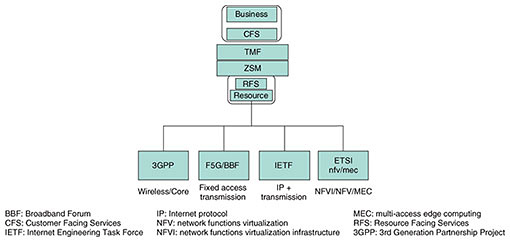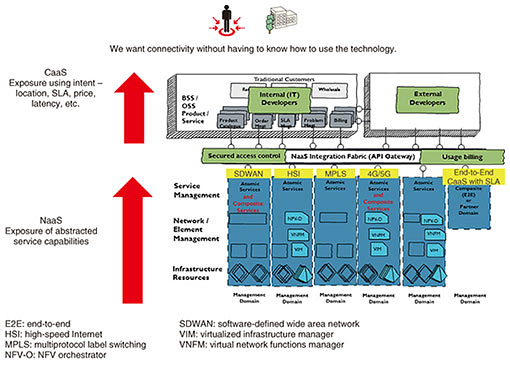 |
|||||||||||||||
|
|
|||||||||||||||
|
Global Standardization Activities Vol. 19, No. 7, pp. 75–80, July 2021. https://doi.org/10.53829/ntr202107gls Latest Activities in TM ForumAbstractSince its establishment in 1988, TM Forum has been shifting from examining and standardizing telecommunication operations (i.e., carrier business support system and operations support system (BSS/OSS)) on the basis of the Telecommunications Management Network model to examining and standardizing next-generation operation-system frameworks/architectures for business-to-business-to-X (where X denotes any end user) services cooperating with other companies and industries. These activities are being carried out in areas of autonomous networks for automating network operations using artificial-intelligence technology and customer experience management for strengthening customer-oriented operations. The NTT Group is promoting its technical and business requirements to be reflected in the standardization process in the forum, as well as examining the architecture of BSS/OSS for digital transformation using the forum”Ēs documentation. Keywords: TM Forum, autonomous network, customer experience management 1. What is TM Forum?TM Forum [1] started as the Open Source Initiative/Network Management Forum in 1988 and is the largest international standardization organization in the telecom management field with more than 850 associated major carriers and vendors worldwide studying industry standards in the operations field to promote interoperability. The Open Digital Architecture (ODA) was proposed as an architecture of business support system and operations support system (BSS/OSS), and the framework to implement this architecture is defined as the Open Digital Framework (ODF). The forum also discusses categories set on the basis of business trends (projectivization), architecture, application programming interfaces (APIs), information models, and so on that are based on specific use cases and scenarios. Discussions have been held on projects such as the Autonomous Network Project, which aims at autonomous network operations, Customer Experience Management (customer-oriented operations) Project, which aims at improving customer satisfaction, and Digital Ecosystem Management Project, which aims at applications for smart cities (including Internet of Things), etc. Proof-of-concept (PoC) (Catalyst) programs are being carried out to demonstrate the feasibility of these standard documents in terms of implementation and applicability in new business fields, and about 40 teams (one team consists of five to ten carriers/vendors) participate annually. These PoCs are exhibited several times a year at TM Forum events (Digital Transformation World, etc.), where a number of carrier vendors demonstrate their new business models and technical capabilities that contribute to the forum’s standardization activities (Fig. 1).
2. Trends in telecommunications businessTraditionally, telecommunications carriers have provided telephone and Internet services as lifelines, and their operations require sustainable connectivity and cost reduction. Accordingly, TM Forum has been studying business process and management information models to meet such requirements. However, new networks, such as fifth-generation mobile communication systems (5G), are increasingly providing network services not only to direct line users such as corporations and individuals but also for businesses involving different industries. Therefore, the main focus of TM Forum has been the architecture and interface (API) of an operation that uses the cooperation between business operators to respond to a business-to-business-to-X (B2B2X) business model shifting from a conventional business-to-consumer (B2C) business model. One of the main features that sets TM Forum apart from other standardization organizations is the emphasis placed on discussions based on business models. To establish architecture, API, and an information model as standards, members of TM Forum discuss these requirements on the basis of business models. In the Catalyst program, carriers and vendors discuss new business models and demonstrate the effectiveness of assets (e.g., standard specifications) stipulated by the forum. The standardization elements necessary for new business requirements are also discussed. 3. Standardization trends3.1 Operational architecture – ODF/ODATM Forum’s Frameworx specifications inherited assets from the New Generation Operations Systems and Software (NGOSS) era, and the forum uses NGOSS documents on enhanced Telecom Operations Map (eTOM), Shared Information/Data model (SID), Telecom Application Map (TAM), Open API, metrics, and best practices to examine these assets. Since around 2018, these frameworks have been drastically changed and restructured as the ODF. The ODA of the system construction in the ODF is discussed on the basis of elements such as the B2B2X business model, customer orientation, and use of artificial intelligence (AI) while inheriting the Frameworx assets (Fig. 2).
In addition to a previous study, a study has begun on ODA-component accelerator (ODA-CA) implementation that accelerates the development of information technology solutions using the ODA. We are also undertaking a large-scale restructuring for using the ODA as a system framework for a wider range of businesses and improving the consistency between the ODA and existing Frameworx assets. On the basis of the concept of enterprise architecture (e.g., The Open Group Architecture Framework (TOGAF)), we are planning to divide ODA documents into business architecture, data architecture, functional architecture, components, and Open APIs and map existing assets such as eTOM, SID, and TAM as libraries. 3.2 APIDiscussions held at TM Forum among various industries along with telecom operators and systems vendors support using APIs (Open API) to create business led by telecom operators and linked with other industries, and 71 companies have agreed on a manifest. There have been several discussions on API suites (a set of necessary APIs) for specific business and network technologies such as edge management component suite APIs, AI closed-loop management component suite APIs, and connectivity as a service component suite APIs. 3.2.1 Autonomous network considerationsTM Forum has been developing a closed-loop framework that automates managed operations through the collection, analysis, optimization, and execution of networks and other managed information. The Autonomous Network Project has been working on business models, architectures, and APIs to extend the closed-loop concept and automate business processes. This is an effort to achieve business automation by linking closed loops at the resource, service, and business layers of a network. In the Autonomous Network Project, the level of automation can be set, and each carrier can objectively determine the level of automation (Fig. 3).
While other standardization organizations, such as European Telecommunications Standards Institute (ETSI) Industry Specification Groups on Zero-touch network and Service Management (ZSM) [2], Experiential Networked Intelligence (ENI) [3], and Fifth Generation Fixed Network (F5G) [4], and open source organizations, such as Open Network Automation Platform (ONAP) [5], are also working on this type of framework for automation, TM Forum is leading a very collaborative effort among these organizations (Fig. 4).
Fiscal year 2020 saw advanced documentation of business requirements and architectures. In the architecture, the concept of an intent (relationship between upper-layer and lower-layer requirements) is being recognized as an element that links closed loops in each layer. Fiscal year 2021 will see advanced discussions on modeling this intent and making it an API. The autonomous network abstracts the infrastructure and treats it as a network as a service (NaaS). In a NaaS, connectivity of services based on location, price, and service level agreement (SLA) is expressed as connectivity as a service (CaaS). Based on the abstraction of the infrastructure, the autonomous network has expanded its scope to include not only 5G networks but also legacy networks, and methods of automating operations using AI are being studied (Fig. 5).
3.2.2 Operations using AIAt TM Forum, there are four items to consider when using AI in operations to make them more effective: (1) Closed-loop AI automation: Exploring architecture that enables automation using AI for anomaly analysis. We are organizing expected use cases and logical architectures for anomaly detection and resolution. (2) AI governance: Studying management and risk-reduction methods to widely deploy operations using AI. We are studying methods of managing operation life cycles using AI, taking into account business alignment and business design. (3) AIOps*1: Studying AI-based operational process designs. We are focusing on operational processes and their governance using AI by analyzing the gap between traditional management processes of service operation on the basis of practices such as DevOps*2 and Information Technology Infrastructure Library and the process based on AI and by providing AIOps service management as a framework based on the extracted requirements. This framework is under consideration. (4) Data governance: Considering an ethical and secure framework. We are considering categorization of learning data for operations using AI and the right to share and use those data.
3.2.3 Customer-oriented operationsThe key quality indicators specialized for services used by customers have been used for customer experience management, and how the service management process improves customer satisfaction has been examined. Considering that many customers use various services in combination, study on the life cycle of service use from the customer’s viewpoint has progressed by taking into account situations in which customers change services according to changes in their lifestyles. Consideration of customer-oriented operations in 5G businesses and operations based on the intent of the customers’ service requirements is a popular topic in TM Forum. 4. NTT Group activitiesThe NTT Group is using TM Forum to understand market trends and technologies for digital transformation, reflect operation technology developed by NTT laboratories in international standards (avoiding “Galápagosization”), create business models that combine market technologies with NTT’s technology, and promote the commercialization of NTT Group packaged products. For example, NTT Access Network Service Systems Laboratories is working on modeling technology for network resource information (NOIM: Network Operation Injected Model) to be reflected in information model requirements for network management and developing related APIs for inter-business cooperation for resource information and internetworking, service, and business cooperation. NTT Group companies participate in the TM Forum Standardization Technical Committee before and after major meetings and events of TM Forum with the aim of integrating activities and operations within the NTT Group. The committee shares upstream and downstream information from each company and shares the trends and relationships of related standardization organizations with TM Forum. It has also established a support system to effectively encourage the upstream and downstream activities of each company. References
|
|||||||||||||||















